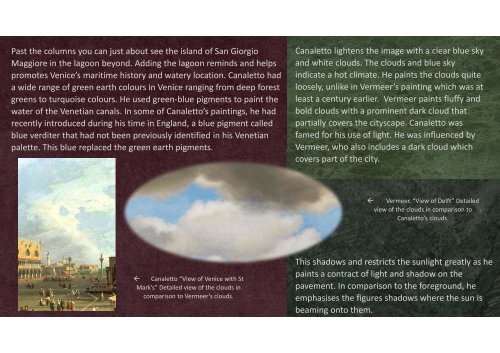You also want an ePaper? Increase the reach of your titles
YUMPU automatically turns print PDFs into web optimized ePapers that Google loves.
Past the columns you can just about see the island of San Giorgio<br />
Maggiore in the lagoon beyond. Adding the lagoon reminds and helps<br />
promotes Venice’s maritime history and watery location. Canaletto had<br />
a wide range of green earth colours in Venice ranging from deep forest<br />
greens to turquoise colours. He used green‐blue pigments to paint the<br />
water of the Venetian canals. In some of Canaletto’s paintings, he had<br />
recently introduced during his time in England, a blue pigment called<br />
blue verditer that had not been previously identified in his Venetian<br />
palette. This blue replaced the green earth pigments.<br />
Canaletto lightens the image with a clear blue sky<br />
and white clouds. The clouds and blue sky<br />
indicate a hot climate. He paints the clouds quite<br />
loosely, unlike in Vermeer’s painting which was at<br />
least a century earlier. Vermeer paints fluffy and<br />
bold clouds with a prominent dark cloud that<br />
partially covers the cityscape. Canaletto was<br />
famed for his use of light. He was influenced by<br />
Vermeer, who also includes a dark cloud which<br />
covers part of the city.<br />
Vermeer. “View of Delft” Detailed<br />
view of the clouds in comparison to<br />
Canaletto’s clouds.<br />
Canaletto “View of Venice with St<br />
Mark’s” Detailed view of the clouds in<br />
comparison to Vermeer’s clouds.<br />
This shadows and restricts the sunlight greatly as he<br />
paints a contract of light and shadow on the<br />
pavement. In comparison to the foreground, he<br />
emphasises the figures shadows where the sun is<br />
beaming onto them.





